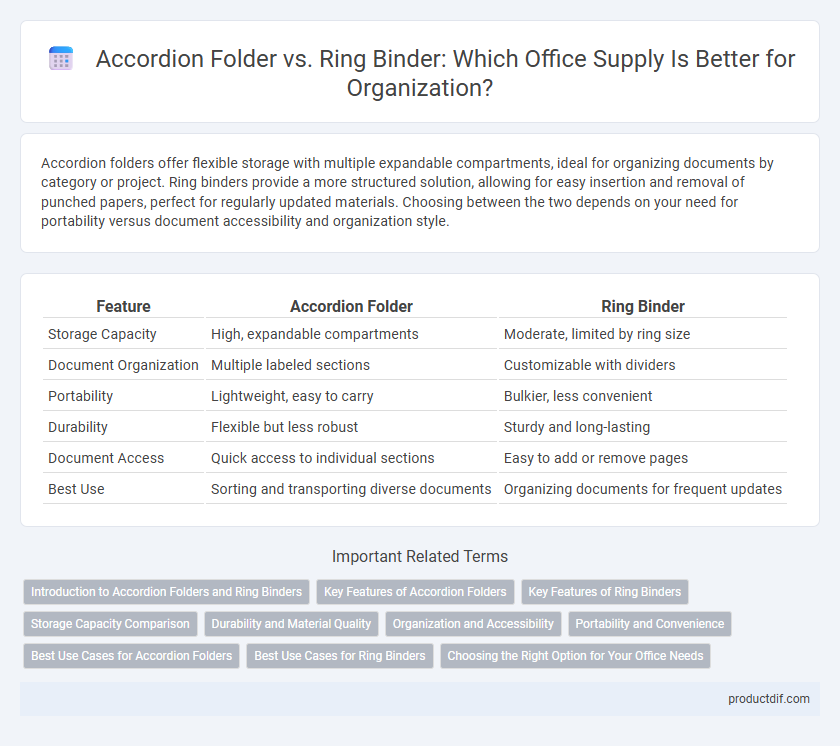Accordion folders offer flexible storage with multiple expandable compartments, ideal for organizing documents by category or project. Ring binders provide a more structured solution, allowing for easy insertion and removal of punched papers, perfect for regularly updated materials. Choosing between the two depends on your need for portability versus document accessibility and organization style.
Table of Comparison
| Feature | Accordion Folder | Ring Binder |
|---|---|---|
| Storage Capacity | High, expandable compartments | Moderate, limited by ring size |
| Document Organization | Multiple labeled sections | Customizable with dividers |
| Portability | Lightweight, easy to carry | Bulkier, less convenient |
| Durability | Flexible but less robust | Sturdy and long-lasting |
| Document Access | Quick access to individual sections | Easy to add or remove pages |
| Best Use | Sorting and transporting diverse documents | Organizing documents for frequent updates |
Introduction to Accordion Folders and Ring Binders
Accordion folders feature expandable, multiple compartments ideal for organizing documents by category or date, offering easy access and portability. Ring binders use a metal ring mechanism to securely hold punched papers, providing customizable organization with the ability to add or remove pages. Both office supplies enhance document management but serve distinct organizational needs based on flexibility and capacity.
Key Features of Accordion Folders
Accordion folders feature expandable gussets that allow for greater storage capacity, accommodating a variety of documents without compromising organization. These files often include multiple labeled sections, making it easier to categorize important papers and access them quickly. The lightweight, portable design of accordion folders enhances convenience for mobile professionals compared to bulkier ring binders.
Key Features of Ring Binders
Ring binders feature sturdy D-shaped or round rings that securely hold hole-punched documents, ensuring easy organization and quick access to papers. Their durable covers, often made from plastic or vinyl, offer protection against wear and tear, ideal for frequent handling in office environments. Adjustable ring mechanisms accommodate varying document thicknesses, making them versatile for projects ranging from a few pages to several hundred.
Storage Capacity Comparison
Accordion folders offer expanded storage capacity with multiple expandable compartments, allowing users to organize a large volume of documents in a compact format. Ring binders typically hold fewer documents but provide secure fastening with customizable inserts, making them ideal for smaller collections or frequently accessed materials. For maximum storage of varied documents, accordion folders outperform ring binders in handling bulkier, categorized files efficiently.
Durability and Material Quality
Accordion folders typically offer durable, flexible construction made from reinforced polypropylene or heavy-duty paperboard, providing lightweight protection against wear and tear. Ring binders are generally constructed with sturdy vinyl or leather covers and metal rings, ensuring long-lasting durability and resistance to frequent opening and closing. Both options vary in material quality, with ring binders often outperforming accordion folders in maintaining structure under heavy use.
Organization and Accessibility
Accordion folders provide flexible organization with multiple expanding compartments, making it easy to categorize documents by project or priority. Ring binders offer a more structured format, using rings to hold punched papers securely for quick access and easy page flipping. Choosing between them depends on whether you prioritize modular storage or the ability to insert and remove pages efficiently.
Portability and Convenience
Accordion folders offer superior portability due to their lightweight design and expandable structure, making them ideal for organizing multiple documents on the go without adding bulk. Ring binders provide convenience with their ability to securely hold punched papers and allow easy page rearrangement, but their rigid form factor can be less practical for frequent transport. Choosing between the two depends on the need for flexible storage capacity versus the ease of document access and organization.
Best Use Cases for Accordion Folders
Accordion folders are ideal for organizing multiple documents by category, making them perfect for professionals handling varied paperwork such as invoices, receipts, and project files. Their expandable design allows easy access and portability, which suits on-the-go office environments or fieldwork. Compared to ring binders, accordion folders offer greater flexibility for documents of differing sizes without the need for hole punching.
Best Use Cases for Ring Binders
Ring binders excel in organizing frequently accessed documents, making them ideal for office settings requiring easy insertion and removal of papers. Their durable construction supports heavy use, while customizable spine labels enhance quick identification in filing systems. Best suited for project management, presentations, and extensive report storage, ring binders accommodate various paper sizes and accessories such as dividers and sheet protectors.
Choosing the Right Option for Your Office Needs
Accordion folders offer flexible storage with multiple expanding pockets, ideal for organizing documents by category without adding bulk, making them perfect for portable use and quick access. Ring binders provide durable, structured storage with customizable inserts and are better suited for long-term document management, easy filing, and presenting reports. Selecting between an accordion folder and a ring binder depends on your office's need for mobility and quick sorting versus structured, archival organization.
Accordion Folder vs Ring Binder Infographic

 productdif.com
productdif.com